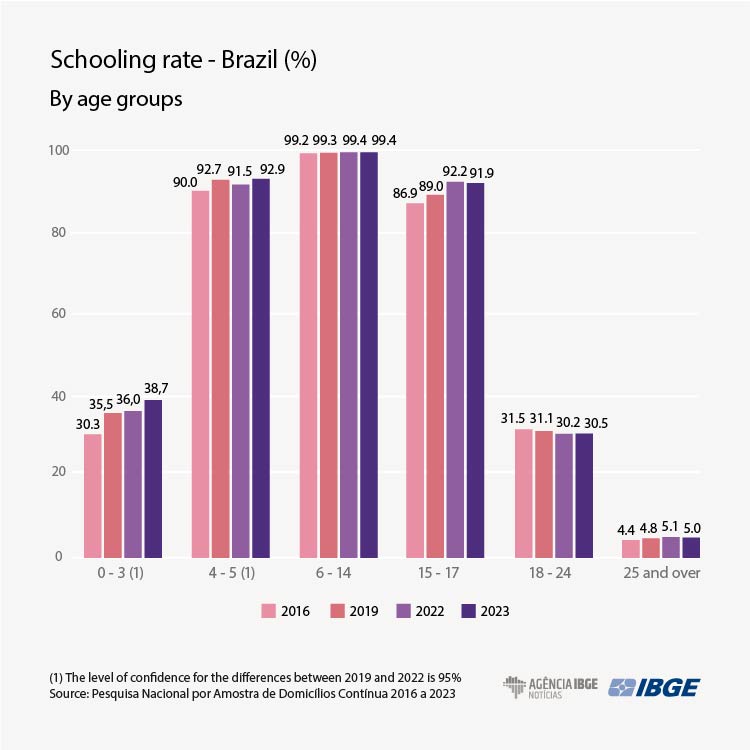Continuous PNAD
Proportion of youngsters aged 6-14 in elementary and middle school drops for the third consecutive year
March 22, 2024 10h00 AM | Last Updated: March 25, 2024 09h05 PM
Highlights
- In 2023, 94.6% of the peersons aged 6-14 were attending elementary of middle school, the recommended school levels for this age group. From 2022, there was a decrease of 0.6 percentage points, resulting in the lowest level of the series, below Target 2 of the National Education Plan (PNE) (95%).
- The schooling rate of teenagers aged 15-17 was 91.9% in 2023 and 75.0% of the teens aged 15-17 were attending high school or had obtained a diploma.
- In Brazil, in 2023, there were 9.3 million illiterate persons aged 15 and over and an illiteracy rate of 5.4%. This rate dropped by 0.2 percentage points (p.p) from 2022 (5.6%), which corresponds to a decrease by approximately 232 thousand illiterate persons in the country.
- In 2023, the illiteracy rate of black or brown persons reached 7.1%, more than twice as that of white persons (3.2%). The illiteracy rate of women aged 15 and over (5.2%) was lower than the rate of men in the same age group (5.7%).
- In 2023, the average years of schooling of persons aged 25 and over was 9.9%, being stable against 2022. The average years of schooling of women (10.1 years) is still above that of men (9.7 years).
- The average years of schooling of white persons (10.8 years) in 2023 was 1.6 year above that of black or brown persons (9.2 years). This difference has changed little since 2016, when it reached 2.0 years.
- The proportion of persons aged 25 and over who completed basic education in Brazil, that is, who obtained at least a high school diploma, remained on an upward trend and hit 54.5% in 2023. The percentage of persons who obtained a high school diploma stood out, with a change from 29.9% in 2022 to 30.6% in 2023.

In Brazil, in 2023, 94.6% of the persons aged 6-14 were attending elementary or middle school, the recommended school levels for this age group. - Photo:. From 2022, there was a drop of 0.6 percentage points, resulting in the lowest level in the series, after a drop between 2019 and 2022 (-1.9p.p) and from 2018 to 2019 (-0.3p.p). As a result, the indicator was below Target 2 of the National Education Plan (PNE) (95%).
The schooling rate of this age group, which measures only school attendance but not the quality of schooling, remained at 99.4%, having kept high results in all the Major Regions and being close to universalization.
The data come from the annual edition of the Continuous National Household Sample Survey (PNAD), Education. See also the news on youngsters who were not working or studying. .
Schooling of persons up to 5 years of age increases
In 2023, 10.1 million children aged 0 to 5 were attending a day care center or school in the country. In the group aged 0-3, the schooling rate was 38.7% (or 4.4 million children in day care centers). Schooling of this age group has increased by 8.4 p.p. since 2016 and by 2.7 p.p., since 2022. The proportion of children aged 4-5 in day care center or school increased from 91.5% in 2022 to 92.9% in 2023, amounting to 5.8 million children.

The schooling rates of persons aged 15 to 17 was 91.9% in 2023. By Major Region, against 2022, this indicator dropped by 2.7 p.p. in the North (89.1%).
Target 3 of the PNE, of achieving universal access to school for the population aged 15-17 up to 2016, had not yet been reached in any Major Region in Brazil. This target also established that net school attendance, that is, age-level adequacy, must reach 85.0% in high school by 2024. In 2023, 75.0% of the youngsters aged 15-17 were attending or had completed high school, that is, the difference between the net adjusted rate and the target was 10.00 percentage points.
“ The Brazilian Major Regions will face challenges and have to pay more attention to school failure, which is observed since the end of middle school,” says Adriana Beringuy, IBGE’s coordinator of household surveys.
Illiteracy remains on a downward trend and is still associated with age
In 2023, the country had 9.3 million illiterate persons aged 15 and over, which is equivalent to an illiteracy rate of 5.4%. Among these persons, 54.7% (5.1 million) lived in the Northeast Region and 22.8% (2.1 million) persons, in the Southeast. From 2022, there was a drop by 0.2 percentage points (p.p.) of this rate in the country, which corresponds to a drop by more than 232 thousand illiterate persons in 2023.
There were 5.2 million illiterate persons aged 60 and over, which is equivalent to an illiteracy rate of 15.4% in this age group. Illiteracy is still concentrated in the older groups. Considering the younger age groups, the rates were 9.4% among persons aged 40 and over; 6.5% among those aged 25 and over and 5.75% in the population aged 18 and over. That indicates younger generations had more access to education.

In 2023, the illiteracy of women aged 15 and over was 5.2%, whereas that of men reached 5.7%. Against 2022, the rate changed by 0.2 p.p. among women.
Considering white persons aged 15 and over, in 2023, 3.2% were illiterate, a percentage that reached 7.1% among black or brown persons. In the group aged 60 and over, the illiteracy rate of white persons was 8.6%, but 22.7% among black or brown ones.
Average of years of schooling is stable, with slight decrease in inequalities
In 2023, the average years of schooling of persons aged 25 and over hit 9.9 years, being stable from 2022. The average years of schooling of women (10.1 years) is still above that of men (9.7 years).
The average years of schooling of white persons (10.8 years) in 2023 was 1.6 year higher that that of black or brown persons (9.2 years). This difference has dropped little since 2016, when it reached 2.0 years.
The Southeast (10.6 years), South (10.1 years) and Central West (10.5 years) remain above the national average of years of schooling, whereas the Northeast Northeast (8.7 anos) and the North (9.5 anos) were below the average. The average of the central West Region recorded the biggest change from 2022: 0.3 years of schooling.
54.5% of the population aged 25 and over had at least complete basic education
In Brazil, the proportion of persons aged 25 and over who had complete basic education - that had at least a high school dipoma - remained on an upward trend and reached 54.5% in 2023. A highlight is the percentage of persons with a high school diploma, which went from 29.9% in 2022 to 30.6% in 2023.
Among persons who did not complete basic education, 6.0% had no schooling, 27.1% had incomplete elementary/middle education, 7.5% had complete elementary/middle education, and 5.0%, incomplete high school education. The groups with incomplete or complete elementary/middle school education recorded drops between 2022 and 2023.
The level of education refers to the school level attained by each person regardless of how long they attended school. As educational paths vary individually, this indicator is most representative when it expresses the regular schooling process in the population aged 25 and over.
More about the survey
The Continuous National Household Sample Survey (Continuous PNAD) investigates, on a quarterly basis, a group of short-term information on the trends and fluctuations of the Brazilian workforce, and, on an annual basis, relevants structural topics that add to the unserstand the Brazilian reality.
The annual Continuous PNAD module of Education analyses illiteracy of persons aged 15 and over, the level of education and the average years of schooling of persons aged 25 and over, the schooling rate by age groups, the adjusted net school attendance rates and the status of employment and schooling of persons aged 15-29, among other topics.
In the second quarter of 2020, first year of the COVID-19 pandemic, the IBGE changed the form of data collection, and the interviews, which were previoulsy conducted face-to-face, started being carried out exclusively by telephone, up to the end of Q2 2021. This form of obtention of data caused impacts on collection and, therefore, a considerable reduction in the success rate of the sample, in 2020 and 2021. Due to the lack of information for this period, the survey time series encompasses the period 2016-2019 and the years 2022 and 2023.



















